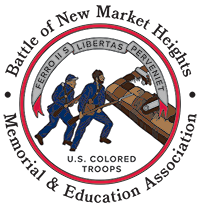
Image From Library of Congress
There was a great deal of skepticism concerning the black man’s combat ability within the Union army. Despite showing well in earlier fights at Battery Wagner, Milliken’s Bend, Port Hudson, and the first days of the Petersburg Campaign, many were still not convinced that when faced with fighting Robert E. Lee’s Army of Northern Virginia’ battle-hardened veterans, the USCTs would be measured and found wanting. Others, however, were thoroughly convinced the black soldiers would fight when given an equal chance and were properly led.
Gen. Benjamin F. Butler, commander of the Army of the James, was in the later camp. In fact, in his memoirs, Butler claimed that the fight at New Market Heights was placed almost wholly on the back of the USCTs to show they could take hot fire and not wilt. Butler wanted to prove to the white Union soldiers that they need not worry when fighting alongside blacks.
The United States Colored Troops were of course fighting to abolish slavery. Many of them, even free men of color, felt their race would not advance with the weight of the “peculiar institution” slowing them all down. Many were also fighting to preserve the Union. Black soldiers, especially those from loyal border slave states, were fully aware to the fact that slavery remained in those regions, but with Lincoln’s Emancipation Proclamation, and the Radical Republicans in control of Congress, progress in the United States was slowly being made. But, many black men enlisted, chanced death, and braved shot and shells to prove they were the equal to any man. If they could prove they were men, citizenship and its accompanying political and social rights should come next.
With skepticism rife in the Union army, one can imagine what most Confederate soldiers thought about their African American adversaries and the motivations or (perceived lack there of) of the USCTs. An interesting example of how preconceived notions can cloud one’s interpretation of events comes from the Battle of New Market Heights, where fourteen black soldiers showed such courage that they received the Medal of Honor for their actions.
Before the USCT attacks the morning of September 29, 1864 kicked off, they were instructed to fix their bayonets, load their rifles but not prime them with percussion caps. They were instructed to keep moving forward, not matter what happened, not stopping to fire less they break their formations, and take the Confederate earthworks, driving out the defenders.
First, the 750 or so men of 4th and 6th USCT regiments which made up Steven A. Duncan’s small brigade went in. They took horrific casualties when they encountered a line of abatis and then a line of chevaux de frise, which broke their formations, slowed them down, and made them perfect targets for the Texans defending the position. Despite losing over 50% killed, wounded, and captured, some continued on up the works, apparently only a few firing occasionally in desperation; most following orders to the end. After about half an hour the handful of white officers no killed or wounded ordered the men to withdraw. Five black soldiers in Duncan’s Brigade received the Medal of Honor for their heroism shown in rescuing their flags or rallying men.
The Texans, however, interpreted the black troops’s lack of firing differently. Some of the Confederates, not believing that African American men had the steel in their nerves to attack such a fortified position believed that the USCTs were being forced forward by white soldiers. Pvt. Benjamin Fitzgerald of the 5th Texas stated: “When the men learned who were advancing, scorning the use of of breast works, they mounted them and quietly waited their approach. Goaded by the bayonets of the white troops in rear they advanced with great desperation and were slaughtered like sheep.” The problem with Fitzgerald’s account is that there were no white troops “in rear.” The attacking black troops were only later supported by other black troops. I’m sure he could not fathom black men, who he had only known as slaves, could fight like the men at New Market Heights did.
Another interesting statement comes from Thomas L. McCarty of the 1st Texas. He noted about that morning: “Up in our line at break of day, about 5 1/2 o’clock. In a few moments we were heavily engaged, the negroes crossed the second line of abatis, and into the first, when the fight raged for a few minutes, men firing on them at about 25 steps. They soon broke and fled with heavy loss.” So far McCarty’s account appears to match other accounts, but then he saw something from his view point. McCarty wrote, “They [USCTs] seemed as if they did not know how to use their guns. . . .” The Texan, naturally, did not know the black soldiers had been ordered not to fire, but instead of thinking of that possibility for why they were not shooting, he likely reasoned they had either not been trained properly or were too scared to work their rifles correctly.
During the Civil War the USCTs found themselves in a unenviable position. Doubted by many on their own side and often put in difficult situations to prove their manhood and ability, they were also despised by their enemies, who found any other reason than black bravery to justify USCT displays of courage.

